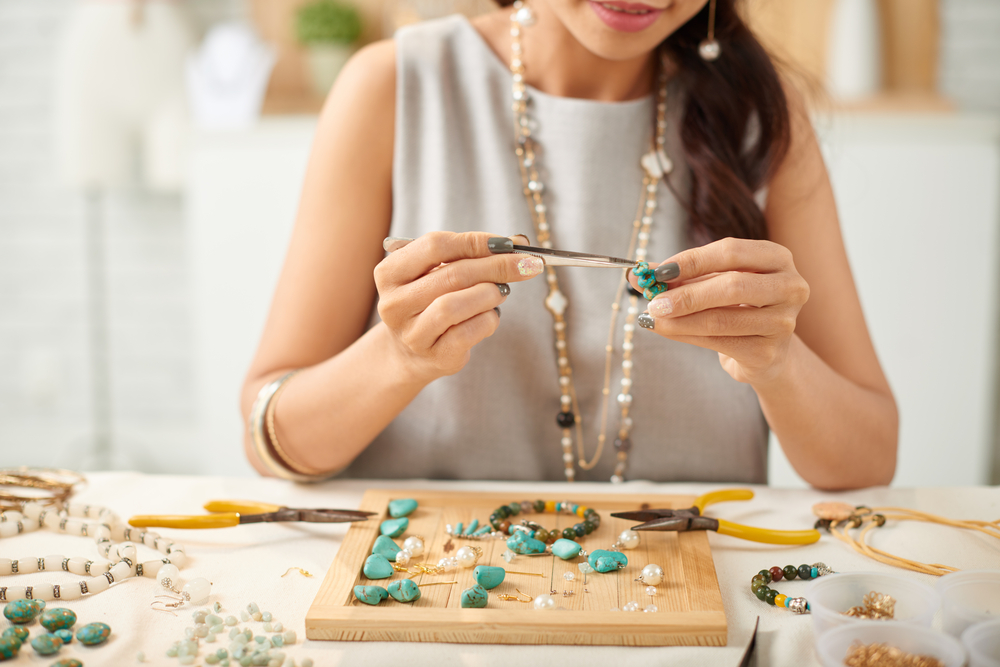- Choosing an Online Jewelry Making Course
- Top 5 Best Online Jewelry Making Classes 2024
- 1. Best for Beginners: Wire Wrapping for Beginners
- 2. Best Metalsmithing Course: Foundations in Metalsmithing
- 3. Best for Ring Making: Silver Stacking Rings
- 4. Best for Soldering: Beaducation – Beginners Jewelry Soldering Tutorial
- 5. Best for Stone-Setting: Jewellers Academy – Stone Setting
- Frequently Asked Questions
- Extra Credit
- Craft Your Future
Whether it’s the finishing touch to a luxury outfit or a bespoke piece in your daily attire, jewelry is a powerful statement of style and personal taste. No matter what type of jewelry you prefer, we can all appreciate the impact that jewelry can have on our outfit, mood, and confidence.
As an artistic craft, jewelry making has been practiced for thousands of years. Historically, jewelry making has been associated with physical dexterity, patience, and creativity. Today, in order to meet the tremendous demand for jewelry items, the modern jewelry making industry has implemented a range of computer-aided, mass manufacturing methods, from laser stamped filigree to high-volume, computer numerical control metal crafting. Unfortunately, store-bought jewelry items have slowly been stripped of character, diversity, and customization options.
If you’re tired of searching for an original piece of jewelry, you might want to consider learning how to make your own jewelry items. If you’re thinking about entering the bespoke jewelry making industry, the best way to get started is by signing up for an online jewelry making course.
Now, before you ask, formal training and certification are not required to make your own jewelry. This is true even if your intention is to start your own jewelry business. Nevertheless, taking an online jewelry making course is an excellent way to learn jewelry craftsmanship and familiarize yourself with best practice jewelry making techniques. What’s more, having a jewelry making certification will add a lot of credibility to your business should you ever decide to leverage your jewelry making skills into a professional pursuit.
Choosing an Online Jewelry Making Course
Before you jump straight into making your own jewelry, you’ll need to start by learning the basics of what goes into making a piece of jewelry. This means understanding the different types of techniques used to create jewelry and the different materials you will be handling when crafting. Taking an online jewelry making course is the quickest and easiest way to brush up on your knowledge, but not all online jewelry making courses are created equally.
When choosing an online jewelry making course, it’s crucial that you pick a course that is suited to your goals, whether they are professional or recreational. To further streamline your decision-making process, make sure to carefully consider the following features when selecting an online jewelry making course.
Knowledge Level
It’s important to determine your current skill and knowledge level before you decide on a jewelry making course. Are you a complete beginner, or do you have an amateur or professional background in jewelry making? If you’re completely new to the craft of jewelry making, you’ll likely be better served taking a more detailed, comprehensive online course. This will ensure that you have access to theory and safety instructions in addition to more hands-on training modules.
If you’ve been making your own jewelry for some time and you’re looking to learn a new technique or level-up your current repertoire of skills, a specialized course addressing a particular aspect of jewelry making will probably be a better use of your time.
The method you focus on is entirely up to you. However, it’s often beneficial to start with a basic method, such as wire wrapping or hand-assembled jewelry, before attempting more complicated process. To give you a better idea of what these terms mean, we’ve described some of the most common jewelry crafting methods in our Extra Credit section.
Length
The time you’ll spend learning how to make jewelry will depend on your current knowledge level, the type of jewelry you’d like to make, and the techniques that are being introduced. The courses we discuss later in this guide range from around 30 minutes for addressing a particular aspect of jewelry making to 4 hours for more intricate designs and specialized skills.
Regardless of the length of the course, most online learning platforms allow you to take a course at your own pace, with videos that you can pause and come back to when you’re ready. This is particularly beneficial if you work, study, or generally have a busy schedule.
Cost
Getting into jewelry making doesn’t have to be a prohibitively expensive hobby. In fact, you can find two of the basic courses in our guide for free online. However, more extensive courses require either an up-front fee or a monthly subscription payment. Many of these courses are offered through online learning platforms like Creative Live or Skillshare.
These platforms offer a variety of different courses aside from jewelry making. If you’re thinking of picking up jewelry making as one of several new hobbies, a subscription service is a fantastic way to try out a number of different skills for an affordable price. Creative Live provides you access to their full range of courses for as little as $13 per month, whereas Skillshare is slightly more expensive at $19 per month.
Alternatively, if you’re focused on pursuing jewelry making as a career or you want access to a particular, skill-focused course, you may be better off paying a one-time fee. This type of course tends to be quite affordable, with typical pricing ranging from $0 to $50.
Additional Equipment
There are several different tools and equipment items that you’ll need in order to begin making your own jewelry. If you already work with a jeweler, you may be able to take advantage of having professional-grade equipment, tools, and materials on hand. If you don’t have access to professional equipment, you can still make high-quality jewelry using some common household tools. For a more comprehensive idea of what tools you’ll need, jump down to our full equipment list below.
Depending on the type of jewelry you’re making, you may find it useful to have the following items on hand:
- Pliers
- Metal cutters
- Metal wire of varying length
- Sterling silver or gold metal
- Gems, stones, or jewels for decoration
- Jeweler’s glue
- Soldering equipment
Most beginner courses will start out using simple tools and equipment, so don’t worry about purchasing everything at once. If you’re starting from scratch, consider purchasing a DIY beginners jewelry making kit. These kits include everything you’ll need to start making basic jewelry at home.
Now that you have a better understanding of what to look out for in a good jewelry making course, let’s take a look at the best online jewelry making courses for 2024.
Course Comparison at a Glance
If you need to find a jewelry making course fast, the following table provides brief descriptions and key facts for our top five online jewelry making courses.
| Course | Description | Quick Facts |
|---|---|---|
| Wire Wrapping for Beginners | Learn all the basic techniques with an interactive community to inspire you along the way. | Cost: $39.99 Level: Beginner Length: 2.5 hrs. |
| Foundations in Metalsmithing | Create intricate, high-quality jewelry with simple metalsmithing techniques. No complicated tools are required! | Cost: $49 or $13/month Level: Beginner/Intermediate Length: 4.15 hrs. |
| Silver Stacking Rings | Designed for beginners, this course focuses on silver crafting and will have you creating stunning jewelry pieces within the hour. | Cost: $19/month Level: Beginner Length: 46 mins |
| Beaducation – Beginners Jewelry Soldering Tutorial | Master the art of soldering, one of the essential skills in jewelry making, under an articulate and knowledgeable industry professional. | Cost: Free Level: Intermediate/Advanced Length: 1.40 hrs. |
| Jewellers Academy – Stone Setting | This quick yet extensive tutorial introduces jewelry makers to the dazzling world of stone setting. | Cost: Free Level: Beginner Length: 30 mins – 1 hr. |
Top 5 Best Online Jewelry Making Classes 2024
1. Best for Beginners: Wire Wrapping for Beginners
- 2 hours $39.99
- Course Highlights
- Style: Wire Wrapping
- Level: Beginner
- Certificate: Yes
Why we like it
Learning the basics is anything but boring in this streamlined, introductory course to wire wrapping.
Course Review
If you’re just starting out in the jewelry making industry and you need to refine your technique, the Udemy Wire Wrapping for Beginners course is the perfect introduction to the use and limits of wire in jewelry making. Depending on the size of your tool kit, this course may require the purchase of additional equipment before you can craft your design.
Across the span of 12 modules, Jessica Barst, an experienced jewelry designer and industry professional, will talk you through everything you need to know to get started. Jessica Barst has designed and manufactured jewelry lines for department stores like Nordstrom and JC Penney. With over 14 years of experience under her belt, Jessica not only introduces jewelry making techniques in a simple and approachable manner but also discusses common troubleshooting tactics in case you make an error during the design and/or crafting process.
Each module contains 2-7 individual lessons, with specific modules introducing earring, bracelet, necklace, and wire drop techniques. Before you begin crafting pieces of jewelry, you’ll have an opportunity to practice the basic techniques by making simple loops and wrapped loops.
In terms of assessable material, this course only includes a short introductory quiz to ensure you’ve understood the different types of wires and materials that are usually used in wire wrapping. Besides this, you don’t need to complete any additional exams to gain certification in this course. As this is a wire wrapping course, you won’t be introduced to soldering or other more advanced jewelry making techniques.
If you’re looking for a more advanced course, take a look at Beaducation: Beginners Jewelry Soldering Tutorial.
Pros
- Overseen by an industry professiona
- Includes certificate
- Suitable for beginners
- Focus on troubleshooting
Cons
- Limited to wire wrapping techniques
- Requires additional tools
2. Best Metalsmithing Course: Foundations in Metalsmithing
- 4.15 hours $49 (or $13/month)
- Course Highlights
- Style: Metalsmithing
- Level: Beginner/Intermediate
- Certificate: No
Why we like it
Master complicated techniques and immerse yourself in cutting-edge design procedures in this comprehensive metalsmithing course!
Course Review
Creating your own unique, high-quality pair of earrings doesn’t have to be a frustrating or laborious process. This course on Foundations in Metalsmithing from Creative Live will walk you through the entire design and creation process, leaving you with a stunning pair of earrings and the skillset to create your own line of jewelry. Not only will you learn about the jewelry design and metalworking process, but you’ll also be introduced to a range of other crafting techniques, including sawing, piercing, and filing.
Over the course of the different modules, you’ll be instructed by Megan Auman, an expert in jewelry design and business. Megan Auman has released her own jewelry collections in main street stores across the United States. As an established metalsmith, Megan will guide you through the basic techniques used in metalsmithing, the different tools that you will use to construct your earrings, and how you can apply these techniques when creating your own line of jewelry. What’s more, Megan’s experience in both business and jewelry design allows her to provide a well-rounded teaching experience that addresses the needs of both hobbyists and aspiring jewelers.
Unlike other entries in this list, this course’s centerpiece project (crafting a pair of statement earrings) has been optimized for material affordability and minimal equipment requirements. Finally, you can rest easy knowing that you won’t have to spend your time completing boring assignments or studying for quizzes in order to complete the course.
Unfortunately, you won’t receive formal certification upon completing this course. However, you will gain life-long skills that you can carry on in both a professional and recreational capacity.
If you prefer rings to earrings, consider taking the Skillshare – Silver Stacking Rings online jewelry making course.
Pros
- Overseen by an industry professional
- Focus on practical experiences
- Minimal equipment and material outlay
Cons
- No certificate provided
- Requires additional tools
3. Best for Ring Making: Silver Stacking Rings
- 46 mins $19/month
- Course Highlights
- Style: Ring Making
- Level: Beginner/Intermediate
- Certificate: No
Why we like it
Master the basics of soldering, filing, and polishing while making a trendy set of stylish stackable rings.
Course Review
In this fun, straightforward course, you’ll be given a complete run-down on some simple soldering techniques that can be used to make a series of delicate, stackable rings.
Over the course of 14 different modules, you’ll receive a thorough introduction to ring making and soldering. This will include a deep dive into the different materials you’ll need as well as any additional tools (you may incur added costs for tools on top of the Skillshare subscription fee).
Self-taught instructor, Joanne Tinely, presents in an organized manner with clear, manageable instructions that will make creating, soldering, and texturing your stackable rings a breeze. With 14 years of experience behind her, Joanne regularly features lines of jewelry at local galleries across the United Kingdom and spends her free time running in-person jewelry making classes in her home studio.
There’s no need to worry about quizzes or tests throughout this course as it is more focused on creating a unique and wearable piece of jewelry. Please note, there is no certification included in this course.
During this course, you’ll have access to the share and comment function on the Skillshare interactive discussion and project platform. This platform allows you to both post photos of your finished pieces and also check out designs posted by your classmates.
If you want to augment your ring-making skills and learn how to set a stone or jewel into a ring, check out the Jewelers Academy: Stone Setting course.
Pros
- Overseen by an industry professional
- Beginner and intermediate friendly
- Includes interactive community learning hub
Cons
- No certificate provided
- Requires additional tools
4. Best for Soldering: Beaducation – Beginners Jewelry Soldering Tutorial
- 1.40 hours Free
- Course Highlights
- Style: Soldering
- Level: Intermediate/Advanced
- Certificate: No
Why we like it
Level-up your jewelry making skills with this simple, informative, and cost-effective soldering tutorial.
Course Review
If you’ve mastered the basics and you’re looking to add a new jewelry making technique to your repertoire, consider taking the Beginners Jewelry Soldering tutorial from Beaducation. Lead by instructor Kate Richbourg, this course focuses on the use of soldering paste and how it can be used, via three different soldering techniques, to create a necklace pendant.
This short course covers 9 different steps, with each step separated into its own short, digestible video tutorial. If you’ve been intimidated by soldering in the past, this course is the perfect introduction to its practical applications. Instructor Kate has been praised for her ability to work through student uncertainty and present difficult techniques in a down-to-earth, easily understandable fashion.
Unlike the other courses on this list, this course requires a significant number of additional tools and materials that may be costly to acquire. Amongst these tools are soldering and polishing equipment as well as various metals, such as copper and silver. Before you begin shopping for these materials, you may wish to watch the class content covering metals — this will provide you with a brief introduction to the different metals that can and cannot be used in soldering as well as the metals you’ll need to purchase for the course project.
As this course requires prerequisite knowledge in soldering and safe soldering techniques, it’s not suitable for people new to soldering and advanced jewelry making. If you’re only just starting out at jewelry making and need a course more appropriate for beginners, take a look at the Udemy: Wire Wrapping for Beginners course.
Pros
- Completely free
- Technique focused curriculum
- Digestible modules
Cons
- No certification
- Requires many additional tools
5. Best for Stone-Setting: Jewellers Academy – Stone Setting
- 30 mins – 1 hour Free
- Course Highlights
- Style: Stone-Setting
- Level: Beginner
- Certificate: No
Why we like it
Brought to you by a passionate community of professional jewelers, this simple stone-setting course will help you create a stunning piece of gem-encrusted jewelry.
Course Review
Learn how to make simple, elegant stone-set rings with a few simple tools and easy-to-follow techniques in this short online jewelry making course. Hosted on the Jewellers Academy platform, qualified instructor Sophie Arnott will walk you through a two-part process that involves preparing and soldering a bezel cup to a silver ring before setting it with a beautiful cabochon stone of your color choice. You’ll have access to a pre-made ring template in order to simplify the process.
Each video in this course is professionally filmed and edited, making it a visual delight to listen and watch all of Sophie’s lectures. Furthermore, if you sign up to the Jewellers Academy website, you’ll gain ongoing access to podcasts, informative webinars, and other tools and materials that can be used to improve your jewelry making techniques — all the material on the Jewellers Academy website is produced by industry professionals with extensive experience in jewelry making.
While this course requires the purchase of additional tools and materials, all of these items serve multiple functions in jewelry making and will likely be an investment item that you will use time and time again in other artistic projects.
It’s important to note that you’ll require a pre-made silver ring in order to complete this project. If you’d rather make your own silver ring, consider taking the Skillshare: Silver Stacking Rings online jewelry making course beforehand.
Pros
- Completely free
- High production values
- Includes pre-made ring settings
Cons
- Requires pre-made ring
- Requires additional tools
Frequently Asked Questions
You do not need any formal qualifications to become a jewelry maker or start making your own jewelry. However, if you wish to work professionally within the industry, you may need to complete an apprenticeship/traineeship under a professional jeweler.
If you’re looking at working as a freelance jeweler, you don’t need any qualifications at all! However, before you jump straight into making jewelry, we strongly recommend that you take an online jewelry course to learn and improve your skills.
You don’t have to be an artist or have any special design skills to create stunning pieces of jewelry! The beauty of making your own jewelry is that you get to choose the design and overall finish of the piece. You may find it helpful to draw out your designs on paper before starting the jewelry making process. This drawing can then be used as a stencil to help minimize potentially irreversible mistakes.
Jewelry making courses are exceptionally affordable, with most courses ranging between $0 and $50. That being said, setting yourself up with the correct tools and materials may mean an initial upfront cost on top of the course fee. However, once you have all the tools you need, you’ll only need to buy materials as needed.
It’s entirely possible to start your own jewelry business after you complete an online jewelry making course. If you already have a full-time job, your best bet is to start out selling jewelry casually or part-time whilst maintaining regular employment. This will ensure that you still have a steady income while you build up your business and hone your skills.
On average, most online jewelry making courses will only take 1-2 hours! However, it’s likely that you’ll only cover the basic techniques in this time period. It can take weeks or even months to fully understand the different techniques that can be used to make jewelry. That being said, learning, practicing, and refining your jewelry making skills will likely be a life-long process and hobby!
Extra Credit
Before you begin your jewelry making journey, there are a number of key terms you should understand, particularly if you plan on learning multiple jewelry making methods. To help you make a more informed decision when shopping for your online course, we’ve listed the most commonly used terminology in the jewelry making industry.
Key Terms
Craft Wire: A type of wire that is used to make various styles of jewelry. Craft wire is available in a wide variety of lengths and thicknesses to suit the style of jewelry being made and will hold its shape far better than regular wire.
Tiger Tail Wire: The most common variety of craft wire used for threading beads or making other basic jewelry items. It is composed of multiple strands of fine wire that are twisted together before being coated in either plastic or nylon.
Findings: A general term for various connective items used in jewelry crafting, such as clasps and pins.
Clasp: The fastening that allows a wearer to put on and take off a piece of jewelry.
Crimp: Made from soft metal, a crimp is used to hold a bead or finding in place on an item of jewelry. Crimps come in many different styles (i.e., clam or charlotte crimps).
Long-Nosed Pliers: As the name suggests, long nose pliers are similar to regular pliers, but they have a longer nose section. Long-nosed pliers are useful for working with smaller beads or on more intricate areas of a piece of jewelry.
ID/OD: These two terms are acronyms for inner diameter and outer diameter. You may encounter these terms when learning how to construct a piece of jewelry.
Jump Ring: A type of finding that is shaped like a ring. However, the end of the ring is not soldered, so the ring can be open and shut.
Round Nosed Pliers: Another common plier variant, often used for looping wire and findings.
Spacer: A bead that is used to space out other beads on your piece of jewelry. Spacers are often made from metal.
Soldering: Soldering is commonly used when working with multiple pieces of metal in jewelry making. This process involves melting two pieces of metal together, either directly or by using a filler metal. The filler metal will need to have a lower melting point than the metal being used.
Wire Knitting/Crocheting: This is the process of knitting or crocheting, but instead of using wool, craft wire is used.
Different Jewelry Making Methods
Before making a final decision on any particular online jewelry making course, there is some additional information you should consider. In order to select the course which best matches your professional and/or recreational goals, you should first have a basic understanding of the different kinds of jewelry making methods that you can learn and the best materials and tools for that technique.
Having even an elementary idea of the kind of jewelry you’d like to make and what to expect in terms of materials and tools, will not only help you to pick an online course, but will also help you to understand what type of jeweler you’d like to be. To help kick-start your learning, we’ve broken down everything there is to know about the jewelry making process, from common methods and equipment to basic materials and most frequently asked questions.
Let’s start with more detailed information on some of the most common jewelry crafting methods.
Hand-Assembled Jewelry
Hand-assembled jewelry is the simple process of assembling unique jewelry pieces from pre-made chains, gems, and/or pendants. The materials you use will typically be hand sourced from markets or wholesalers before being assembled together in a style that is unique to you and your brand. This is a simple and easy way to start making your own jewelry, as it only requires you to source the jewelry components rather than make the metalwork from scratch.
Wire-Wrapped Jewelry
Wire wrapping acts as a decorative framework for the main embellishment and is a frequently used technique amongst beginners or jewelers working with pendants, stones, charms, and beads. While wire wrapping may seem simple at first glance, it can take a lot of practice and patience to create delicate, lightweight designs.
Metalsmithing
Metalsmithing, or fabricated jewelry, uses a combination of metalworking and soldering to join multiple components of a piece of jewelry together. Metalsmithing is considered to be a more advanced form of jewelry making as it requires expertise across a range of difficult techniques.
Beaded Jewelry
While it’s a simple method, beaded jewelry can be both intricate and elaborate. To make beaded jewelry, a piece of stringing material, such as wire or line, is used to hold a selection of designer beading. Given an ample supply of beads, you can create a vast number of different designs using a very simple threading technique, making it a great technique for beginner jewelers and teenagers. Nevertheless, beaded jewelry doesn’t have to be limited to simple pieces — you can incorporate beading into any jewelry making technique.
Hand-Stamped Jewelry
Hand-stamped jewelry is one of the best techniques for creating unique and personalized pieces of jewelry. When using this technique, indents and impressions are made on a piece of metal using hammering and customized stamping devices. You should begin practicing metal stamping on cheaper cuts of metal (i.e., aluminum or copper). Once you have some experience and confidence in the technique, you can begin working with higher-value metals (i.e., 14 karat gold or sterling silver).
Hand-stamped jewelry isn’t limited to shapes or patterns. You can use a sharpened engraving tool to write your name, the name of a loved one, or to create a special pattern on your piece of jewelry. Hand engraving requires a lot of patience and skill, so be sure to practice your engraving on a piece of scrap metal before you start on your own piece of jewelry.
Enameled Jewelry
If you want to add color or a glassy, enamel finish to your jewelry, enameling is an easy to learn and affordable option. Enameled jewelry uses a glass powder that fuses to the surface of a metal, creating a long-lasting bond once the piece has been torch-fired (you can use a soldering torch to do this).
Tools and Equipment
Before you begin to make your own jewelry, you’ll need some basic tools and equipment. Rather than trying to source these tools individually, many people find it easier to purchase a jewelry making kit. These kits include all the basic tools you’ll need to get started with basic jewelry making techniques. For an affordable, beginner jewelry making kit, check out the Paxcoo Jewelry Making Supplies Kit. You may need to purchase additional tools for more complicated techniques, such as soldering or enameling.
Some tools that you will find useful include:
- Pliers
- Hammers
- Sandpaper
- Metal stamps
- Prong pusher and bezel roller (for setting stones)
- Magnifying visor
- Flex shaft
- Wire cutters
- Ring gauges (for sizing rings)
- Metal ruler, scribe, and dividers
- Hand drill
- Calipers (this is used to measure metals)
If you plan on soldering your jewelry, you’ll need additional tools. The most important equipment you’ll need for soldering is safety goggles, a heavy-duty apron, and a fire extinguisher. You’ll be soldering metals at extremely high temperatures, so it’s important that you have the proper safety equipment and that you take your time while you’re still familiarizing yourself with the tools and techniques. Check out this basic Soldering Iron Kit for a high-quality, intro set of soldering tools.
Most soldering kits will include the following equipment:
- Torches
- Pickle and pickle pot
- Tongs
- Soldering surfaces
- Solder pick
- Solder material
- Tweezers
- Shears
- Binding wire
For a better idea of what these tools are used for and a more comprehensive list of other tools you may need, have a read through this informative article from The Gem Society.
Metals
There is an abundance of metals that can be used to make fine jewelry. Each metal variety has its own unique properties, with each requiring different techniques and, in some cases, different tools, to manipulate the metal into its desired form.
To give you a head start in metalworking theory, we’ve briefly described four of the most commonly used metals in jewelry making.
Gold and Sterling-Silver
Gold and sterling-silver are two of the most popular jewelry metals, with each being used to make earrings, rings, necklaces, and other types of jewelry. Importantly, sterling-silver is a softer metal than both yellow and white gold, so it tends to be a bit easier to work with for beginners. As a general rule of thumb, individuals with cool skin tones tend to suit sterling-silver jewelry, whereas individuals with warmer skin tones are better suited to gold jewelry.
Platinum
Rather than using white gold, some jewelry makers prefer to use platinum. This is because it doesn’t need to be split into alloys in order to achieve a silver/white color. Platinum is also extremely hard and long-wearing, making it a fantastic option for individuals who work with their hands or spend lots of time in nature.
Stainless Steel
Stainless steel is not a common material in jewelry making. However, thanks to its lightweight and durable properties, the use of this metal has grown more popular in recent years, particularly when crafting simple bands and piercings.
Titanium and Tungsten
Two other long-lasting materials are titanium and tungsten. Both of these metals are scratch-resistant and incredibly strong. For this reason, titanium and tungsten are popular for use in male wedding rings and watches.
For a more thorough description of the properties of each metal, take a look at this handy guide to metals in jewelry.
Craft Your Future
In addition to saving a fortune in store-bought jewelry, learning how to create your own jewelry accessories also opens up a range of new hobbies, side gigs, and career possibilities. Now that you have a better idea of what you need in order to start making your own jewelry, it’s time to choose your very own online jewelry making course. Whether you’re pursuing jewelry in your spare time or as a full-time profession, an online jewelry making course will prepare you for what to expect and give you the tools you’ll need to succeed.






